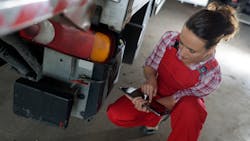Connected technicians more productive, workforce study finds
For over two years, strains on the trucking industry have pushed maintenance technician teams to their limits to keep the country moving. COVID-19 has pinched all aspects of the labor market; a tightening workforce has been pressured to repair trucks and delivery vehicles and keep them on the road despite shutdowns during virus outbreaks and the supply chain logjams that followed. At the same time, the explosion of mobile computing as a facet of our personal lives has opened the eyes of workers everywhere to how much more effective they can be with technology at work. For the first time ever, workers are driving the direction and pace of technology in the workplace.
At the intersection of these converging realities comes a massive shift in workplace expectations. Your teams now feel their employers must take all the steps necessary to ensure workflows are streamlined, critical information is available at their fingertips, and efficient communication is available across teams. Arming your workers with mobile technology will revolutionize productivity while giving your teams what they are asking for. Some of the benefits include sophisticated data capture and the ability to share it in real time, dispatching of teams, clickable inventory management, maintenance management platforms that use machine learning to predict problems before they occur, tools that enhance communication across dispersed locations—the list goes on.
As we continue to see more mobile apps replace legacy workflows, maintenance teams are leveraging the advanced functionality of tablets and smartphones, especially as business leaders realize the benefits in parallel. Whether issuing COPE (Company Owned/Personally Enabled) devices as a business perk or instating a BYOD (Bring Your Own Device) policy, commercial repair facilities that enable their employees to embrace the strengths mobility brings to the shop will see heightened productivity. Mobile devices are essential to how work gets done, particularly so for deskless workers. Like all the powerful tools in your shop, having effective use policies is essential to reaping all of the benefits, while curbing the potential risks.
While maintenance management and communication applications spur collaboration and flexibility, the very devices they are housed in pose risk if functionality is left unmanaged. Workers can struggle to regain focus after interruptions, and for those in hazardous environments where focus is critical, outcomes cannot be left up to question. While on the job, your workers are often left to construct their own boundaries for how they interact with their mobile device, imposed with the burden of juggling productivity and safety while working. So, what role can employers play in helping establish and maintain those boundaries?
Balancing mobility and productivity
TRUCE Software’s second annual Connected Workforce survey revealed the largest segment of respondents feel the best way an employer can attract, retain, and enable success at work is through enabling a balance between personal life and work matters. The second largest segment said offering the latest technology is the best way to do so. To assist in the balancing act, maintenance technician employers must first understand that focusing too much on what workers don’t need rather than what they do is a critical error.
The assumption that mobility will impede on productivity and safety rather than enhance it limits the potential benefits of mobility for the workforce. By identifying what workers need to get the job done efficiently and effectively and focusing on providing that to them, employers can bolster productivity and safety while ensuring the workforce has the tools to finish their work at work. This supports employee work/life balance by establishing boundaries for the worker, a responsibility that employees under the age of 45 feel more inclined to believe should at least partly fall on their employer—according to the Connected Workforce survey.
The survey also revealed that nearly half of all respondents believe work-related technology such as mobile devices and apps will enable them to become more productive at work. Workers today consider mobile devices to be their personal toolkits, containing a virtually limitless supply of applications aimed at solving different problems. However, our desires and impulses seem to have a natural tendency to impede our better judgment when it comes to the use of our phones and tablets. Workers need autonomy on the job to foster innovation, yet equally need guidance to help them define boundaries.
Maintenance technician teams will benefit from employer support in striking the right balance between allowing workers to access mobile devices and enabling autonomy, productivity, and safety through mobility. Busy commercial vehicle repair facilities need employees to be able to access workflow and project management platforms, internal communications platforms, e-ticket software, and more on mobile devices. When properly enabled, mobile devices can accelerate workflows and boost communication without the added risks mobility can present when unchecked.
Flexibility for the future
Retaining employees is a priority for companies in 2022. As trucking maintenance leaders aim to retain their staff amid the Great Resignation, enabling a flexible and productive workforce will encourage employees to stay put while keeping them engaged through maintaining peak productivity, efficiency, and a level of autonomy and device freedom.
The ongoing pandemic, in tandem with preexisting trends toward digitalization, has made mobility in the workplace a necessity. The most pervasive barriers to advancement are deeply rooted in issues of employee safety and reduced productivity. While most U.S. adults believe their devices make them productive, employers’ concerns are valid. The congested history of mobility management solutions that fail to account for contextual factors like location, time, and proximity to dangerous equipment impedes on all the advantages of increased mobility. When properly managed across the workforce through dynamic enforcement of device permissions, mobility fosters safety, productivity, flexibility, and autonomy.
Joe Boyle is CEO of TRUCE Software, the first platform to offer a contextually aware and responsive mobile management solution for businesses.
About the Author

Joe Boyle
CEO | TRUCE Software
Joe Boyle is CEO of TRUCE Software, the first platform to offer a contextually aware and responsive mobile management solution for businesses.
